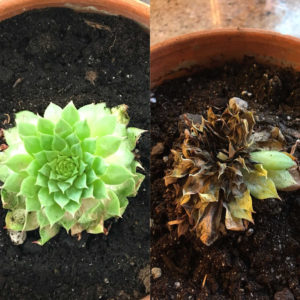
Why can’t I get a sempervivum (also known as hens and chicks) to survive? I’ve grown succulents like jade and haworthia plants that have propagated many new plants. They’re all over my house.
But I’d just about had it with failure after failure with hens and chicks when I reached out to Altman Plants for help. Bob Reidmuller is resident horticulturist at Altman Plants, one of the largest greenhouse operations in the United States. He looked at all the details of my situation and shared an absolute treasure trove of information with me on this succulent. It was as if I made one bad decision after another about caring for these plants, and the dominoes all fell quickly after that.
“A common mistake with succulents is that when they start looking bad, people start giving them more water,” Reidmuller told me. “Nine times out of ten the water caused the problem in the first place and the roots are rotting or collapsed. More water just finishes things off!”
So here’s how to care for hens and chicks properly, according to Reidmuller.
Domino #1: Pot size. If you are growing each sempervivum in its own pot, the pot should be just a bit bigger than the plant. When the pot is too big, its enormous soil volume gets wet and stays wet. The plant and the roots don’t want to sit in damp soil for the length of time it would take for it to dry out. This is a perfect recipe for root rot.
I did this wrong right off the bat. While some succulents may be more forgiving than sempervivums, they all run this same risk. It is better to gradually move them into bigger and bigger pots as they fill out the previous smaller ones.
Domino #2: Drainage. Be sure that your containers have drainage holes. Otherwise, you’re going to have succulent soup and, again, root rot.
Domino #3. Soil mix. The soil mix should be very well-draining, not heavy and soggy. You can improve your mix with Perlite or pumice.
Domino #4: How to water succulents. When you water, do it thoroughly so the entire soil mass gets wet and water is flushing out of the drain hole in the bottom.
“Never let the pot sit in a saucer of standing water,” Reidmuller says. “Once it has been thoroughly watered it shouldn’t need watering again for probably a week. This varies due to ambient humidity, sunlight, lots of things.”
So here’s a trick from Reidmuller: Push a bamboo skewer or wooden chopstick into the pot all the way to the bottom and leave it there. When the stick is dry about half way down inside the soil, it’s time to water. If not, put it back in and check again later.
“One rule of watering succulents is that if you are not sure if it needs watering, don’t,” Reidmuller says. “They will survive drier conditions longer far better than being too wet too long.” Also, clay pots dry out faster than plastic pots. Personal preference, watering practices and where the plants are growing help you decide which type of pot is best for you.
A Better Way To Grow Sempervivum
Growing succulents indoors is usually very difficult because of insufficient light.
“There are some succulents that are perfectly happy spending the winter under a blanket of snow, and actually need that for optimum health and performance,” Reidmuller says. “Sempervivums are one of them!”
Healthy sempervivum plants that are acclimated to being outdoors can be grown outside in full to partial sun all year, even in containers. In cold, rainy winter areas, potted sempervivums should be moved to a protected area (under the eaves of the house or under light corrugated plastic or something similar) to keep out winter rains. These types of overhead cover will keep the pots drier.
So in the end, my sempervivum couldn’t be saved, but I’ll try again next year — outside with new, healthy plants.
Leave a Reply